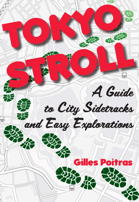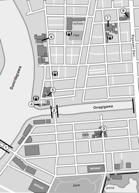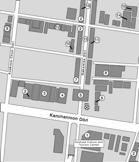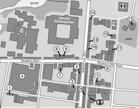











Tokyo Stroll Supplement: Chōfu

This page is for locations in the city of Chōfu in Tokyo. This city is not part of my book Tokyo Stroll.
For information on Tokyo Stroll and this web supplement see Tokyo Stroll Supplement home page
For users of the Organic Maps, Maps.Me and Google Maps apps the items below have bookmarks you can import into those apps to make navigation easier.
Instructions and links are on the Viewing Locations in Organic Maps, Maps.Me, Google Maps, or Google Earth page.
Some entries on this page may include a note that says "Description to be added soon ." These entries are for items I felt should be listed even if the description is not ready to assist those who wish to plan a trip. When possible I included a link to an official web page, I suggest also doing web searchs for more information.
Chōfu Shi (調布)
In 1955 the towns of Jindai & Chōfu were merged to form the present city of Chōfu, The most famous resident of the new city of Chōfu was Mizuki Shigeru (1922-2015). Statues, manhole covers, murals, and more with characters from Mizuki's most popular manga, GeGeGe no Kitarō, are found in several locations in the city. Chōfu is also famous for the large Jindaiji temple and the many soba restaurants near it.
Official pages for each of the cities and towns of will have sections of interest to visitors. These will likely be labeled as dealing with culture, tourism, or events.Chōfu Shi official site: https://www.city.chofu.lg.jp
Bicycle Parking Lot No.1 / Chofuekikita Dai 1 Bicycle Parking (調布駅北第一自転車駐車場)
The streetside wall of this building has a large mural of Kitarō, Medama Ōyaji, Neko Musume, and Ittan momen.
NEAREST TRAIN/SUBWAY STATION: Chōfu Station (Keiō Line, Keiō Sagamihara Line)
Chōfu City Cultural Hall Tazukuri (調布市文化会館 たづくり)
Contains the GeGeGe Gallery (ゲゲゲギャラリー), large display of drawings of yōkai and manga illustrations by Mizuki Shigeru in the lobby of the Chōfu City Cultural Hall Tazukuri (調布市文化会館 たづくり)
NEAREST TRAIN/SUBWAY STATION: Chōfu Station (Keiō Line, Keiō Sagamihara Line)
WEB: https://www.chofu-culture-community.org
GeGeGe no Kitarō character manhole covers
Six manhole covers installed in March 2016 on both sides of Dentsūdai Dōri north of Chōfu Station and continuing to the intersection with National Route 20. They are mainly at the intersections, the only one not is in front of the entrance to the Parco store. The order the are in from south to north is: Kitarō and Medama Ōyaji, Nezumi Otoko and Kitarō, Konaki Jiji, Nezumi Otoko and Neko Musume, Sunakake Baba, Ittan momen and Nurikabe.
NEAREST TRAIN/SUBWAY STATION: Chōfu Station (Keiō Line, Keiō Sagamihara Line)
GeGeGe no Kitarō character statues on Tenjin Dōri
Six polychrome statues on the Tenjin Dōri Shopping Street starting at Kyū Kōshū Kaidō (Tokyo Metropolitan Route 119) and ending at Kōshū Kaidō (National Route 20). These statues are mainly in the middle of the blocks, only one is above eye level at the south end of the street. In order, starting at the south end of Tenjin Dōri, they are: Kitarō on the street sign for the shopping street, Kitarō on the street itself, Nezumi Otoko, Neko Musume and Ittan momen Statues, Nurikabe, and finally another Kitarō statue.
NOTE: Beginning at Kyū Kōshū Kaidō the entrance to Tenjin Dōri Shopping Street is one block east of Dentsūdai Dōri.
NEAREST TRAIN/SUBWAY STATION: Chōfu Station (Keiō Line, Keiō Sagamihara Line)
Jindai Botanical Gardens / Jindai Shokubutsu Kōen (神代植物公園)
The largest botanical garden in Tokyo founded in 1961, before WWII it was a nursery providing trees for Tokyo, after WWII it became the Jindai Green Zone, then it was redefined as the gardens we have today. The garden contains 4,500 varieties of over 100,000 trees and shrubs in 42 hectares. The layout of the garden is in thirty areas, each with a focus on different flora types. A few of the areas in the garden are:
A section of the natural forest of the Musashino Plain.
A world-famous rose garden with 5,200 rosebushes of some 400 varieties.
Tropical and subtropical plants in the greenhouse which opened in 1984. The green house has a rest area with tables and vending machines.
A large lawn including a section devoted to pampas grass.
An aquatic plant garden, free admission, in a separate annex nearby on the other side of the Jindaiji temple complex.
Plus various other sections devoted to specific plants.
With a level of worldwide botanical variety viewing the garden changes as the seasons progress.
NEAREST TRAIN/SUBWAY STATIONS:
Chōfu Station (Keiō Line, Keiō Sagamihara Line) Take the No. 34 bus (showing 調 34) at the central exit bus stop #14 bound for the Jindai Botanical Garden bus stop.
Kichijōji Station (JR Chūō/Sobu Line, JR Chūō Line (Rapid) Take the No. 04 bus (showing "吉 04") at the South Gate bus stop #6 bound for the Jindai Botanical Garden stop.
ACCESS: There are two ticket gates for the paid areas of the garden. The Main Gate is on the west side, and the Jindaiji gate is near the temple on the south east side. Tickets are for the day so you can exit and re-enter at any time.
Admission is free on May 4 which is Green Day (Midori-no-hi) and October 1 which is Tokyo Citizens Day (Tomin-no-hi).
HOURS: Open: 9:30 AM to 5:00 PM (last entry at 4:00 PM)
CLOSED: Mondays (or Tuesday if Monday is a national holiday) and from December 29 to January 1.
EVENTS:
Plum Blossom Festival: Early in the year during the blooming of the garden's 210 plum trees.
Cherry Blossom Festival with special illuminations and extended hours for viewing the garden's 600 cherry trees.
Spring Rose Festival usually in late May at the peak bloom of the roses.
Autumn Rose Show: A second viewing of the roses in full bloom usually in mid-October.
Chrysanthemum Exhibition in the Fall with the flowers in various artistic arrangements.
WEB: https://www.tokyo-park.or.jp/park/jindai/
Jindaiji (深大寺)
A large Tendai Buddhist temple complex founded in 733. Legend has it a young woman wished to marry a man her mother did not approve of, she prayed to Jinja Daiō and her mother agreed. In thanks the girl had the temple founded. Main image of the temple is a statue of Amida Nyorai. The main hall was rebuilt in 1919 after extensive damage from fires in 1646 and 1865. The sanmon, main temple gate, is thatched and dates from 1695. The current bell in the bell tower was cast in 2001, the previous bell is stored at the temple and dates from 1376. The Ganzandaishi Hall contains a statue of Ryōgen (912–985), who is also known as Ganzan daishi and was the 18th chief priest of the Tendai sect. This statue is rather large being 2 meters (6.5 feet) tall, it is the largest statue of a seated monk in Japan. Much like statues of hidden buddhas this statue is only shown to the public at a special event called a gokaichō. This particular Gokaichō is held every 25 years, the next one will be in 2034. Another significant statue at Jindaiji is the Hakuhō Buddha, a statue of Shaka Nyorai from the late Asuka period. This large statue was found under the Ganzandaishi Hall in 1909, there is no record on how it came to the temple. The statue was designated a National Treasure by the government of Japan. People pray at Jindaiji for a marriage partner and to be rid of bad luck, the main place for prayers is Ganzandaishi Hall. The forested temple grounds are bordered by several parks including the spacious Jindai Botanical Gardens and the Jindai Botanical Park Aquatic Botanical Gardens. The neighborhood is also a culinary destination as there are many soba restaurants near the temple.
NEAREST TRAIN/SUBWAY STATIONS:
Chōfu Station (Keiō Line, Keiō Sagamihara Line) Take the No. 34 bus (showing 調 34) at the central exit bus stop #14 bound for the Jindaiji bus stop.
Kichijoji Station (JR Chūō/Sōbu Line, JR Chūō Line (Rapid) Take the No. 04 bus (showing "吉 04") at the South Gate bus stop #6 bound for the Jindaiji bus stop.
EVENTS:
The Goma fire ritual is held every day at Jindaiji at 11 am and 2 pm, on weekends they have a third ritual at 1 pm.
March 3rd and 4th is the Yakuyoke Ganzan Daishi Festival where Daruma dolls are sold.
In Mid October to celebrate the fall moon the monks chant in from of the main gate.
In Mid November there is an annual soba festival.
WEB: https://www.jindaiji.or.jp
Kitarō Square / Kitarō Hiroba (鬼太郎ひろば)
A park with many statues and objects related to the GeGeGe no Kitarō manga. Frome east to west as you walk through the park these include: a statue of Kitarō, Nurarihyon statue & bench, Yamabiko statue and bench, Kappa no Sanpei Pond, the Nurikabe climbing wall, the Neko Musume Restroom, the Kitarō House Slide, and the Ittan momen bench.
NEAREST TRAIN/SUBWAY STATION: Chōfu Station (Keiō Line, Keiō Sagamihara Line)
Kitarō Teahouse / Kitarō Chaya (鬼太郎茶屋)
A teahouse and shop with a theme of the popular manga GeGeGe no Kitarō serving a variety of dishes. Fans of GeGeGe no Kitarō from all over the world visit when they come to Japan. The teahouse is divided into three sections: The Yōkai Cafe with a variety of beverages and snacks, the Yōkai Shop Gegege no Mori sells a variety of goods, some are exclusive to the shop, the Yōkai Gallery which displays art of Mizuki Shigeru mainly related to yōkai.
NOTE: In 2024 the Kitaro Teahouse relocated to the present location on the Tenjin-dōri Shotengai near Chōfu Station. The building at the old location near Jindaiji was in bad shape so they were forced to relocate.
NEAREST TRAIN/SUBWAY STATIONS: Chōfu Station (Keiō Line, Keiō Sagamihara Line)
WEB: http://kitaro-chaya.jp/
Sparrow's Inn / Suzume no Ōyado (雀のお宿)
An excellent soba restaurant with a spacious dining area, large windows overlooking the garden and nearby woods. The menus is centered on soba, tempura, and a variety of Japanese sweets for dessert. Besides tea they have a mellow aged coffee that does not clash with the food.
NEAREST TRAIN/SUBWAY STATIONS:
Chōfu Station (Keiō Line, Keiō Sagamihara Line) Take the No. 34 bus (showing 調 34) at the central exit bus stop #14 bound for the Jindaiji bus stop.
Kichijoji Station (JR Chuo/Sobu Line, JR Chūō Line (Rapid) Take the No. 04 bus (showing "吉 04") at the South Gate bus stop #6 bound for the Jindaiji bus stop.
NOTES: Non-smoking, outdoor seating available, limited seating for those with pets
CLOSED: Tuesdays
Yōkai Mail Box / Yōkai posuto (妖怪ポスト)
A regular Japan Post mailbox modified to resemble the one in GeGeGe no Kitarō. The planning for this was by the shopping store association and supervised by Mizuki Productions.
NEAREST TRAIN/SUBWAY STATION: Chōfu Station (Keiō Line, Keiō Sagamihara Line)
Back to the Tokyo Stroll Supplement home page - Privacy Notice - Back to Gilles' home page
Created August 24, 2024 | Content last updated July 28, 2025